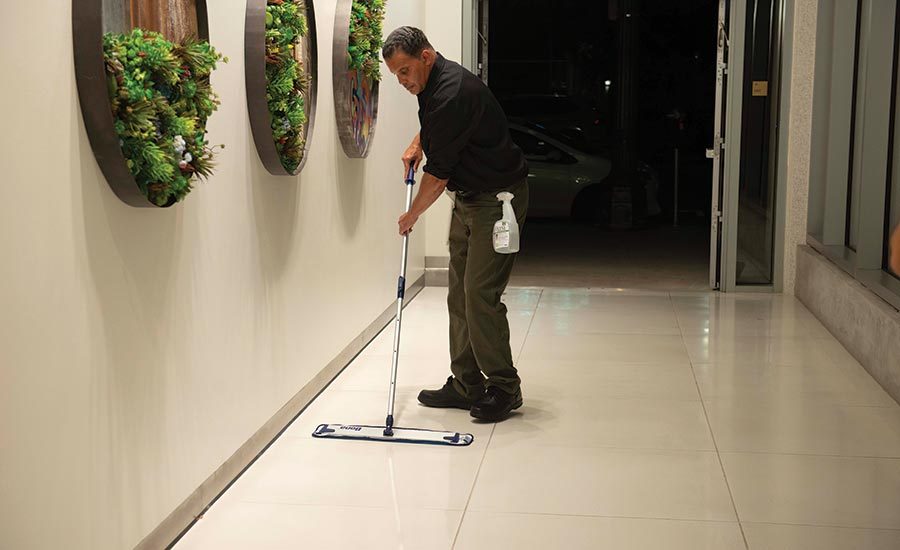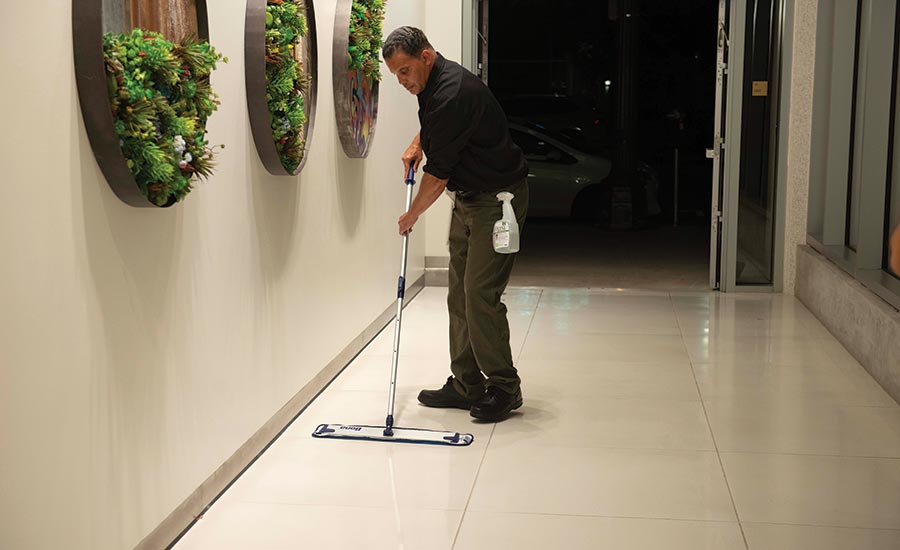Clean Floors: How to Clean, Sanitize and Disinfect Commercial Floors

The disinfectant used by RD Weis can be safely sprayed around people, pets, and food, so it’s an ideal choice for treating a range of commercial spaces.
Photo courtesy of RD Weis.

RD Weis crew members don personal protective equipment (PPE) per the Centers for Disease Control and Prevention (CDC) guidelines. Tyvek suits, gloves, goggles, booties, and masks are worn for each job.
Photo courtesy of RD Weis.

Bona manufactures products that are designed to clean and protect commercial hardwood and resilient flooring.
Photo courtesy of Bona.



As we continue to live with COVID-19, there’s an increased emphasis on maintaining flooring, with services on offer that are designed to keep floors clean—and virus-free. From protocols, to equipment and disinfectants, there’s plenty to consider when deciding on the proper cleaning, sanitizing, and disinfecting of commercial flooring. Floor Trends spoke with manufacturers and flooring professionals to find out more about effective maintenance for pandemic and beyond.
“The three pillars are cleaning, sanitizing, and disinfecting, and they are each different things,” said Ben Giamichael, founder and managing partner of Arch 180, Inc., a sales agency that represents commercial flooring manufacturers. Indeed, people often assume that these processes are interchangeable, however they are separate tasks that achieve different results.
Cleaning is a common practice, one that most of us perform every day in our homes. It is the process of removing dirt, dust, or debris. Once the dirt is removed, a detergent and water is applied to wash a surface. Before the pandemic, cleaning was only done when soil was visible. “Pre-COVID-19, we typically cleaned for aesthetics, like when the floor looked dirty,” said Jim Mannes, national director, Shaw.
Cleaning not only keeps surfaces looking fresh, it also prepares them for proper sanitizing and disinfecting. “Sanitization reduces the amount of bacteria or virus on a surface. Disinfection eliminates it,” said Randy Weis, CEO and founder of RD Weis, a full-service commercial flooring provider. The typical disinfectants found in the supermarket are not strong enough to eradicate COVID-19. “The EPA has drawn a strong line regarding the efficacy of products that make a disinfection claim. They must kill 99.999% of a virus,” Weis added.
In early March, the Environmental Protection Agency (EPA) released its initial List N: Disinfectants for Use Against SARS-CoV-2. The list began with just 85 products, and it is updated on a weekly basis. Now with more than 500 approved products and counting, service providers can select the safest and most effective disinfectants.
Jesse Castro, director of maintenance at Texan Floor Service, a commercial flooring company that provides both products and services, selected a product found on List N as part of a two-pronged system. His crews use electrostatic sprayers to apply Vital Oxide, a hospital-grade disinfectant made of chlorine dioxide that eliminates viruses. Because Vital Oxide is safe to apply around people, pets, and food, it is an ideal choice for a range of spaces.
After treatment with Vital Oxide, customers can choose to have interiors treated with Bio-Protect 500, a surface protectant that inhibits the growth of mold, mildew, and bacteria. “We use Vital Oxide, and that product kills pathogens within 10 minutes, including COVID-19. Bio-Protect 500 protects a surface for 90 days after it is applied. Right now, I would say 95% of our customers are using our system, which is these two products,” noted Castro.
When the pandemic began, the Texan Floor Service teams were most often called in to disinfect office spaces, but in the past six months they have been doing work for general contractors, a new business segment that continues to grow. “We’ll go to the job sites and disinfect their trailers, forklifts, and any other type of equipment that they use,” Castro added.
For flooring service providers, the right disinfectants are crucial, but the gear is just as important to ensure the safety of their workers. Weis said his crews are outfitted in personal protective equipment (PPE) per the Centers for Disease Control and Prevention (CDC) guidelines. Tyvek suits, gloves, goggles, booties, and masks are worn for each job. “We look like the Ghostbusters. When we go into a space to disinfect, we make the assumption that it is infected.”
Some dealers have transitioned to maintenance as a way to keep business up and running during the pandemic, applying their knowledge of flooring installation to this area of care. “I know a lot of dealers on the installation side, soft and hard goods. They’ve started doing maintenance and disinfection, and that helps,” Castro said.
Companies providing cleaning and sanitization services will continue to see an increase in demand, as there is a renewed focus on flooring specifically. “As we’ve watched the trends over the course of the last eight months, the floor aspect of cleaning protocols has been very low on the list, even though the amount of traffic that happens on the floor is second in a building only to walls. We’re trying to educate and bring more awareness around the importance of keeping your floor as clean as you’re trying to keep everything else,” said Tiffany Baird, director of marketing, professional and new initiatives, Bona.
Not everyone though has flooring or disinfection expertise. That can be a problem for building owners looking to save money when budgets are especially tight. “I will say, like most things, the misconception is that we can have this done by anybody and everybody,” Weis said. “A lot of companies that are in pest control have entered the disinfection business this year, primarily because they own some spray equipment. Commercial painters have entered the arena as well. Cost is always a factor, but you really shouldn’t be taking chances with somebody just because their price will be lower in some cases.”
Education is key across the board, especially as businesses and consumers are still learning about how chemicals will affect flooring and interior finishes over time. “People are making big investments in commercial flooring, but there’s not a lot of knowledge about what these particular disinfectants do to hard surfaces long term,” Giamichael said.
The products we use today were created when floor care was a much simpler proposition. In the midst of the pandemic, our needs have changed drastically, and they’ll continue to evolve. “Many if not most of these products were developed for very occasional use, not daily or multiple times a day. What we have found is that a lot of these products are aggressive, and they can have some deleterious effects. We’ve rushed to treat, but we haven’t rushed to learn and understand the long-term ramifications,” Mannes explained.
Disinfection is the new security, it’s a different kind of security.
– Randy Weis
Giamichael noted that flooring manufacturers need to provide more detailed information about disinfection in printed and online materials. “There’s recommendations from all the manufacturers on cleaning procedures. That’s been done. When we start talking about disinfecting though, they don’t have these chemicals listed on their warranty sheets, and they have to be there. We need to start doing some of our own testing, and then develop updates, but it’s not an overnight thing.”
As we continue to learn more about all of these processes, it is clear that disinfecting will become a regular part of our floor care routine. “Disinfection is the new security, it’s a different kind of security. Most people, including myself, are not confident this ends with COVID-19. There’ll be something else, so I think disinfection is here to stay,” Weis added.
Looking for a reprint of this article?
From high-res PDFs to custom plaques, order your copy today!











